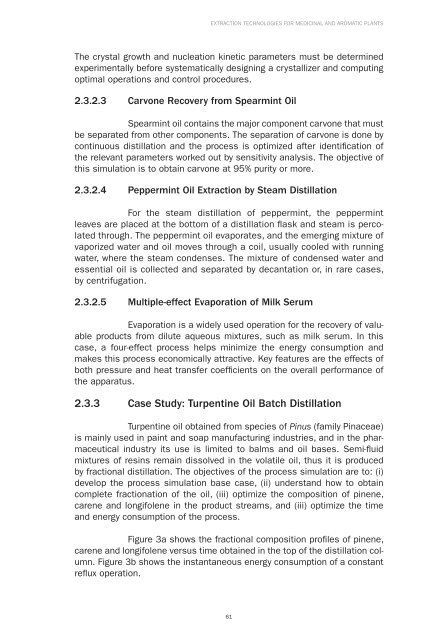Extraction Technologies For Medicinal And Aromatic Plants - Unido
Extraction Technologies For Medicinal And Aromatic Plants - Unido
Extraction Technologies For Medicinal And Aromatic Plants - Unido
You also want an ePaper? Increase the reach of your titles
YUMPU automatically turns print PDFs into web optimized ePapers that Google loves.
EXTRACTION TECHNOLOGIES FOR MEDICINAL AND AROMATIC PLANTS<br />
The crystal growth and nucleation kinetic parameters must be determined<br />
experimentally before systematically designing a crystallizer and computing<br />
optimal operations and control procedures.<br />
2.3.2.3 Carvone Recovery from Spearmint Oil<br />
Spearmint oil contains the major component carvone that must<br />
be separated from other components. The separation of carvone is done by<br />
continuous distillation and the process is optimized after identifi cation of<br />
the relevant parameters worked out by sensitivity analysis. The objective of<br />
this simulation is to obtain carvone at 95% purity or more.<br />
2.3.2.4 Peppermint Oil <strong>Extraction</strong> by Steam Distillation<br />
<strong>For</strong> the steam distillation of peppermint, the peppermint<br />
leaves are placed at the bottom of a distillation fl ask and steam is percolated<br />
through. The peppermint oil evaporates, and the emerging mixture of<br />
vaporized water and oil moves through a coil, usually cooled with running<br />
water, where the steam condenses. The mixture of condensed water and<br />
essential oil is collected and separated by decantation or, in rare cases,<br />
by centrifugation.<br />
2.3.2.5 Multiple-effect Evaporation of Milk Serum<br />
Evaporation is a widely used operation for the recovery of valuable<br />
products from dilute aqueous mixtures, such as milk serum. In this<br />
case, a four-effect process helps minimize the energy consumption and<br />
makes this process economically attractive. Key features are the effects of<br />
both pressure and heat transfer coeffi cients on the overall performance of<br />
the apparatus.<br />
2.3.3 Case Study: Turpentine Oil Batch Distillation<br />
Turpentine oil obtained from species of Pinus (family Pinaceae)<br />
is mainly used in paint and soap manufacturing industries, and in the pharmaceutical<br />
industry its use is limited to balms and oil bases. Semi-fl uid<br />
mixtures of resins remain dissolved in the volatile oil, thus it is produced<br />
by fractional distillation. The objectives of the process simulation are to: (i)<br />
develop the process simulation base case, (ii) understand how to obtain<br />
complete fractionation of the oil, (iii) optimize the composition of pinene,<br />
carene and longifolene in the product streams, and (iii) optimize the time<br />
and energy consumption of the process.<br />
Figure 3a shows the fractional composition profi les of pinene,<br />
carene and longifolene versus time obtained in the top of the distillation column.<br />
Figure 3b shows the instantaneous energy consumption of a constant<br />
refl ux operation.<br />
61

















